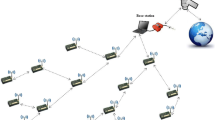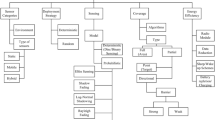Abstract
Topology Maintenance Protocols are vital elements that influence Wireless Sensor Networks. These protocols strive to conserve energy and to prevent collisions during communication. In this paper, a Secured Energy Conserving Slot-based Topology Maintenance Protocol, which serves its purpose by overthrowing several existing issues such as energy deterioration and memory overhead, is proposed. Energy conservation is achieved by node behavior based on timeslot. Hence for a particular timeslot, only certain count of nodes remain in work cycle, and the remaining nodes remain in the state of sleep. This conserves energy at its best, which in turn improves the lifespan of the network. Additionally, the issue of memory overhead is resolved by allowing only direct communication between the node and the base station, and hence the base station directly authenticates the constituent nodes. This work widens its scope by focusing on security breaches too. We introduce five attacks to the system; however, the system proves its resilience. The proposed work outperforms the existing system in terms of energy conservation, increase in network lifetime and less memory overhead.










Similar content being viewed by others
References
Gabrielli, A., Mancini, L. V., Setia, S., & Jajodia, S. (2011). Securing topology maintenance protocols for sensor networks. IEEE Transactions on Dependable and Secure Computing, 8, 450–465. doi:10.1109/TDSC.2009.46.2.
Conti, M., Di Pietro, R., Gabrielli, A., & Mancini, L. V. (2011). Secure topology maintenance and events collection in WSNs. Security and Communication Networks. doi:10.1002/sec.280.
Wang, Y., Li, F., & Dahlberg, T. A. (2008). Energy-efficient topology control for three-dimensional sensor networks. International Journal of Sensor Networks. doi:10.1504/IJSNET.2008.019253.
Zhu, C., Zheng, C., Shu, L., & Han, G. (2012). A survey on coverage and connectivity issues in wireless sensor networks. Journal of Network and Computer Applications, 35, 619–632.
Li, M., Li, Z., & Vasilakos, A. V. (2013). A survey on topology control in wireless sensor networks: Taxonomy, comparative study, and open issues. Proceedings of the IEEE. doi:10.1109/JPROC.2013.2286656.
Xhafa, F., Li, J., Wong, D.S., & Palmieri, F. (2014). Advances in security and privacy in sensor networks. International Journal of Distributed Sensor Networks, 2014, 956265. doi:10.1155/2014/956265.
Khan, S.U., & Lavagno, L. (2012). Security in wireless sensor networks. Global Journal of Computer Science and Technology Network, Web and Security, 12(16).
Yu, Y., Li, K., Zhou, W., & Li, P. (2012). Trust mechanisms in wireless sensor networks: Attack analysis and countermeasures. Journal of Network and Computer Applications, 35, 867–880.
Modares, H., Salleh, R., & Moravejosharieh, A. (2011). Overview of security issues in wireless sensor networks. In Computational intelligence, modelling and simulation (CIMSiM). Third international conference (pp. 308–311).
Jinwala, D., Patel, D., & Dasgupta, K. (2012). FlexiSec: A configurable link layer security architecture for wireless sensor networks. arXiv preprint arXiv:1203.4697.
Conti, Mauro, Di Pietro, R., Mancini, L. V., & Mei, A. (2011). Distributed detection of clone attacks in wireless sensor networks. IEEE Transactions on Dependable and Secure Computing. doi:10.1109/TDSC.2010.25.
Wei, W., Xu, F., Tan, C.C., & Li, Q. (2012). Sybil defender: Defend against Sybil attacks in large social networks. In INFOCOM, 2012 Proceedings IEEE (pp. 1951–1959).
Ren, F., He, T., Das, S., & Lin, C. (2011). Traffic-aware dynamic routing to alleviate congestion in wireless sensor networks. IEEE Transactions on Parallel and Distributed Systems. doi:10.1109/TPDS.2011.24.
Tague, P., & Poovendran, R. (2007). Modeling adaptive node capture attacks in multi-hop wireless networks. Ad Hoc Networks, 5, 801–814.
Chou, C. H. A., Ssu, K. F., Jiau, H. C., Wang, W. T., & Wang, C. (2011). A dead-end free topology maintenance protocol for geographic forwarding in wireless sensor networks. IEEE Transactions on Computers. doi:10.1109/TC.2010.208.
Krishna, M. B., & Doja, M. (2011). Swarm intelligence-based topology maintenance protocol for wireless sensor networks. IET Wireless Sensor Systems. doi:10.1049/iet-wss.2011.0068.
Wang, X., Xing, G., Zhang, Y., Lu, C., Pless, R., & Gill, C. (2003). Integrated coverage and connectivity configuration in wireless sensor networks. In Proceedings of the 1st international conference on Embedded Networked Sensor Systems (pp. 28–39).
Mamun, Q. (2014). A Coverage-Based Scheduling Algorithm for WSNs. International Journal of Wireless Information Networks. doi:10.1007/s10776-013-0231-7.
Sun, Z., Wu, W., Wang, H., Chen, H., & Xing, X. (2014). A novel coverage algorithm based on event-probability-driven mechanism in wireless sensor network. EURASIP Journal on Wireless Communications and Networking. doi:10.1186/1687-1499-2014-58.
Boulfekhar, S., & Benmohammed, M. (2013). A novel energy efficient and lifetime maximization routing protocol in wireless sensor networks. Wireless Personal Communications. doi:10.1007/s11277-013-1081-4.
Gentili, M., & Raiconi, A. (2013). α-Coverage to extend network lifetime on wireless sensor networks. Optimization Letters, 7, 157–172.
Nan, G., Shi, G., Mao, Z., & Li, M. (2012). CDSWS: Coverage-guaranteed distributed sleep/wake scheduling for wireless sensor networks. EURASIP Journal on Wireless Communications and Networking. doi:10.1186/1687-1499-2012-44.
Stergiopoulos, Y. J., & Tzes, A. (2011). Decentralized swarm coordination: A combined coverage/connectivity approach. Journal of Intelligent and Robotic Systems. doi:10.1007/s10846-010-9537-1.
Dłotko, P., Ghrist, R., Juda, M., & Mrozek, M. (2012). (Distributed computation of coverage in sensor networks by homological methods. Applicable Algebra in Engineering, Communication and Computing. doi:10.1007/s00200-012-0167-7.
Dohare, U., Lobiyal, D., & Kumar, S. (2014). Energy balanced model for lifetime maximization in randomly distributed wireless sensor networks. Wireless Personal Communications. doi:10.1007/s11277-014-1759-2.
Qureshi, H. K., Rizvi, S., Saleem, M., Khayam, S. A., Rakocevic, V., & Rajarajan, M. (2013). Evaluation and improvement of CDS-based topology control for wireless sensor networks. Wireless Networks. doi:10.1007/s11276-012-0449-9.
Qureshi, H. K., Iqbal, A., & Asif, W. (2014). Topology control for harvesting enabled wireless sensor networks: A design approach. Wireless Personal Communications. doi:10.1007/s11277-014-2195-z.
Mostafaei, H., & Meybodi, M. R. (2013). Maximizing lifetime of target coverage in wireless sensor networks using learning automata. Wireless Personal Communications. doi:10.1007/s11277-012-0885-y.
Cheng, M. X., & Gong, X. (2011). Maximum lifetime coverage preserving scheduling algorithms in sensor networks. Journal of Global Optimization. doi:10.1007/s10898-010-96363.
Özdemir, S., Bara’a, A. A., & Khalil, Ö. A. (2013). Multi-objective clustered-based routing with coverage control in wireless sensor networks. Soft Computing. doi:10.1007/s00500-012-0970-x.
Bulut, E., & Korpeoglu, I. (2011). Sleep scheduling with expected common coverage in wireless sensor networks. Wireless Networks. doi:10.1007/s11276-010-0262-2.
Özdemir, S., Bara’a, A. A., & Khalil, Ö. A. (2013). Multi-objective evolutionary algorithm based on decomposition for energy efficient coverage in wireless sensor networks. Wireless Personal Communications. doi:10.1007/s11277-012-0811-3.
Akhlaq, M., Sheltami, T. R., & Shakshuki, E. M. (2014). C3: An energy-efficient protocol for coverage, connectivity and communication in WSNs. Personal and Ubiquitous Computing. doi:10.1007/s00779-013-0719-2.
Karlof, C., & Wagner, D. (2003). Secure routing in wireless sensor networks: Attacks and countermeasures. Ad Hoc Networks. doi:10.1016/S1570-8705(03)00008-8.
Younis, M., Senturk, I. F., Akkaya, K., Lee, S., & Senel, F. (2014). Topology management techniques for tolerating node failures in wireless sensor networks: A survey. Computer Networks. doi:10.1016/j.comnet.2013.08.021.
Bhattasali, T., Chaki, R., & Sanyal, S. (2012). Sleep deprivation attack detection in wireless sensor network. arXiv preprint arXiv:1203.0231.
Author information
Authors and Affiliations
Corresponding author
Rights and permissions
About this article
Cite this article
Raja Rajeswari, S., Seenivasagam, V. Secured Energy Conserving Slot-Based Topology Maintenance Protocol for Wireless Sensor Networks. Wireless Pers Commun 87, 527–550 (2016). https://doi.org/10.1007/s11277-015-3103-x
Published:
Issue Date:
DOI: https://doi.org/10.1007/s11277-015-3103-x




